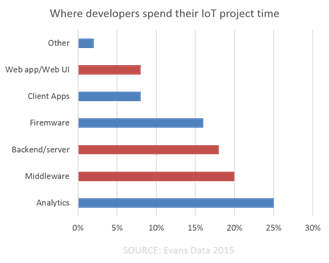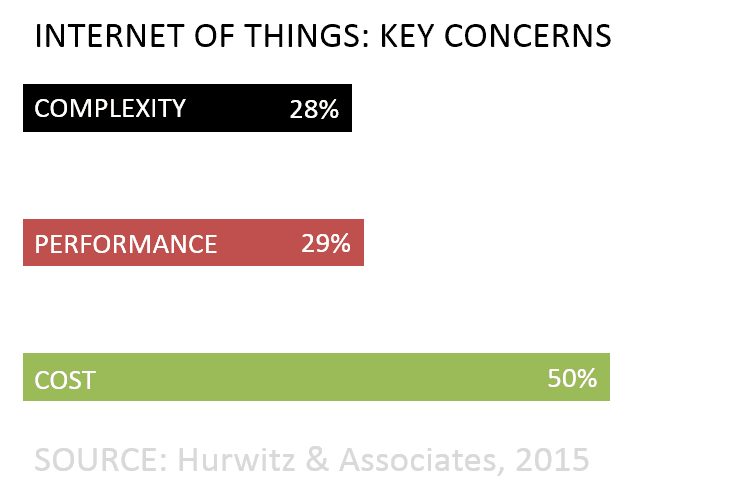A portable Gluten sensor.
Wireless speaker in a light bulb.
The number of “things” invading the market today is incredible, and every day brings something new and perhaps unexpected. The sheer volume of innovation around the Internet of Things would lead you to believe that most of the resources dedicated to such efforts are focused on, well, things.

Of course you know I’m going to say now that this is not the case at all. Because you know me by now, I’m like that.
The reality is that nearly while things talking to things is a significant component to IoT, the other side of the market is definitely the apps that things ultimately talk to (and get talked to by). According to the Evans Data 2015 Global IoT Development survey nearly half of developers are working on supportive apps: middleware, back-end systems, and web-based UIs for management and control. The project type most cited as the focus of IoT development? Workplace automation.
While the fun side of IoT is certainly in new gadgets and toys with which to play (c’mon, who doesn’t like gadgets?) the business side of IoT is in apps, and productivity, and process optimization. Businessy concerns that are, in fact, as critical to the success of IoT as the latest gizmo that consumers will go gaga over.
This is not a new notion. Early in 2014 Gartner had identified this reality and the applicability of IoT to business operations, in particular:
“"The IoT connects remote assets and provides a data stream between the asset and centralized management systems. Those assets can then be integrated into new and existing organizational processes to provide information on status, location, functionality, and so on. Real-time information enables more accurate understanding of status, and it enhances utilization and productivity through optimized usage and more accurate decision support. Business and data analytics give insights into the business requirements data feed from the IoT environment and will help predict the fluctuations of IoT-enriched data and information.” [emphasis mine] ”
For all we want to view the Internet of Things as our latest technology playground (and it is) this is serious business, with serious implications for the data center that will be able to scale, secure, and deliver the penultimate product of IoT: its data. Foremost in businesses minds today is not how to productize and monetize the IoT, but rather how to leverage it to produce greater value out of existing systems and optimize business processes as a prelude to growth. If the process can’t scale, neither can the business.

It’s not that much different than the driving factors behind DevOps and Agile; the processes governing development and deployment simply didn’t scale well enough to meet the growth in demand. So they adopted tools and technology and automated and orchestration and fed data back into the loop to optimize it until it they could deliver and deploy umpteen times a day. Now the business needs to do the same; not just in the data center but on the manufacturing floor and out there, on the roads and in their supply chains and their distribution channels.
And “things” are purported to be the way that’s going to happen.
Which means you, in IT, are going to have to support the apps on the back-end with their middleware and data storage components. You’re going to need to scale to new heights, and architect new solutions to help mitigate their key concerns of performance and cost.
The data center may be partially moving to the cloud (all reports indicate that where there’s IoT there’s cloud…) to support these apps and the voluminous data being generated, but that doesn’t abrogate IT’s responsibility to coming up with services and architectures that will assist in deploying and delivering these new backend, web-based applications with the scale, security, and performance necessary to ensure the solutions achieve their intended results: to optimize the business. Whether in the data center or in the cloud (or some combination thereof), services will need to be deployed - just as they always have. The key is to find a solution that's going to bridge both data center and cloud and provide operational consistency no matter where the app might live and to ensure a more seamless operational experience for those tasked with managing apps, resources, and services in a hybrid cloud environment.
Things will be talking to things, yes. But just as often they’ll be talking to apps, and vice-versa. It is those apps that will most directly impact traditional IT in every enterprise. Because when it comes to delivering, scaling, and securing applications – regardless of whether they’re talking to things or people – IT is the one who’s always tasked with getting it done.
About the Author

Related Blog Posts

Nutanix and F5 expand successful partnership to Kubernetes
Nutanix and F5 have a shared vision of simplifying IT management. The two are joining forces for a Kubernetes service that is backed by F5 NGINX Plus.

AppViewX + F5: Automating and orchestrating app delivery
As an F5 ADSP Select partner, AppViewX works with F5 to deliver a centralized orchestration solution to manage app services across distributed environments.

Build a quantum-safe backbone for AI with F5 and NetApp
By deploying F5 and NetApp solutions, enterprises can meet the demands of AI workloads, while preparing for a quantum future.

F5 ADSP Partner Program streamlines adoption of F5 platform
The new F5 ADSP Partner Program creates a dynamic ecosystem that drives growth and success for our partners and customers.
F5 NGINX Gateway Fabric is a certified solution for Red Hat OpenShift
F5 collaborates with Red Hat to deliver a solution that combines the high-performance app delivery of F5 NGINX with Red Hat OpenShift’s enterprise Kubernetes capabilities.
Phishing Attacks Soar 220% During COVID-19 Peak as Cybercriminal Opportunism Intensifies
David Warburton, author of the F5 Labs 2020 Phishing and Fraud Report, describes how fraudsters are adapting to the pandemic and maps out the trends ahead in this video, with summary comments.
